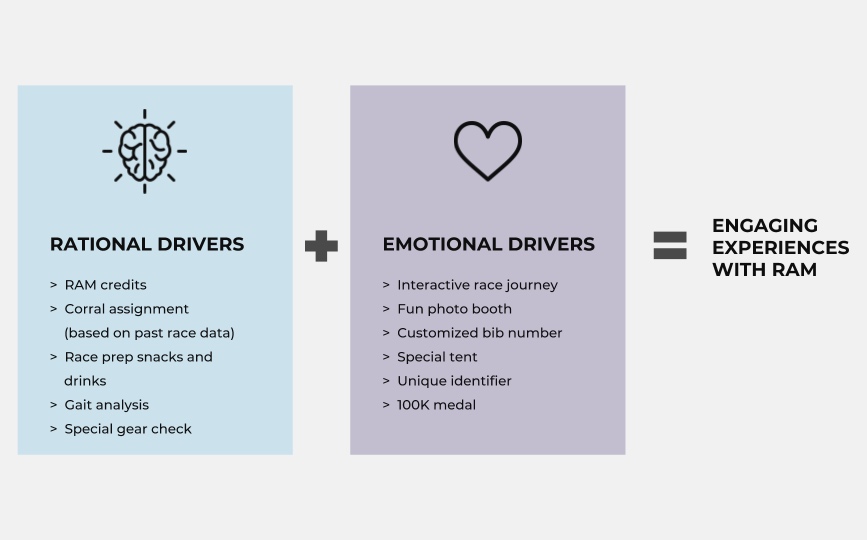RAM Racing
Client: RAM Racing
Team: Diane Wee, Jeshwanth Srinivasan, Prapti Jha, Adithya Ravi
Mentor: Ann Conway
Period: August 2018 to December 2018
RAM Racing is a company that organises some of the largest running races in the Midwest. They invited us to help them improve their service offerings for runners.
Brief
RAM posed us with two questions or challenges:
How can we get runners to come back to a specific race year after year?
RAM uses a platform called EnMotive to host the data from the numerous races they organise. The second challenge was “How can we personalise the race experience for runners using the existing race data?”
Research
Our research for this project involved observation of race day activities, shadowing runners (by participating in the races ourselves) and interviewing runners. We visited three races - the Mag Mile race, the Bucktown 5K race, the Chicago Marathon and an AIDS awareness race that was not organised by RAM (for a comparative study).
We were looking for three key aspects during the research:
Opportunities and lapses in the existing service
A specific type of runner we could identify as a target user
What was RAM already doing well as a race organiser
Some of the pictures we took as part of our research
Insights
They key insights we gathered were:
I feel an anticipation at the start of each race which builds up [throughout the race experience] into excitement
RAM is really good at setting up a noticeably different race experience [as compared to other race organisers]
I love to be rewarded for whatever I have achieved. For a lot of us, it is our first time and a reward feels great
I am always looking for ways to be motivated to run more often
Target User
The target user we identified and used as our guide for the rest of the project was titled an “Intermittent Social Runner”:
Intermittent - While they appreciate RAM’s prowess at organising unique race experiences, they are vulnerable to promotions from other brands as well.
Social - The motivations of these runners are more to do with the external validation for their achievements at a race.
Reframing the Design Challenge
Based on our research, we realised that racers needed to find motivation to return to RAM Racing as a trusted and preferred brand. The existing brand was dispersed due to having a separate webpage for each race and a lack of motivation from runners to build a sense of loyalty with the brand. We decided to reframe our design challenge to reflect these findings as follows
“How might we bring the racers back to the RAM ecosystem while building a relationship with the organisation?”
The Framework and Prototypes
In order to reimagine the service offerings, we devised a framework that encapsulates the motivations for our target users to build a lasting relationship with RAM.
We also developed prototypes of specific touchpoint in the new service and categorised them into “emotional” and “rational” drivers. This helped us establish the motivation behind these suggestions.
Our final concept was to elevate engagement by using data in constructive ways to tell the runner more about themselves while making them feel more privileged for being loyal to the RAM brand.
The framework
Prototypes and the related drivers
Journey Map and Reimagined Service Blueprint
The original journey map
The future service blueprint
The new journey map that shows how a runner levels up with each race he/she runs with us and what emotions, tangible perks and rational benefits they gain.
Service Walkthrough
While the journey map and service blueprint were deliverables that represented our ideas to the client, in order to validate the prototypes with our potential runners, we organised a service walkthrough where runners were taken through the major touch-points of the new service.
A mock up of the unified web interface we suggested
A three time legacy runner at the Hot Chocolate Race takes part in our walk through
Data Models and Personalisation of the Race Experience
We devised many touch-points in the service that would make use of data models constructed by us using existing data. One shown here, is that of an interactive “race story” platform that allows a runner to use images taken of him/her during a race organized by RAM and construct a visualisation over the course map of the race.
As social runners, posting the completion of a race and pictures of events from it is a very common behavior that we observed. However, a runner would have to manually tag RAM in these posts. In order to make this post more memorable, interactive and involve other in-race data (such as pacing throughout the race and elevations in the race course) we developed the above asset.
We also ended up using the existing in-race data to create suggestions for training programs and other perks as a runner goes through the journey of becoming a loyal RAM racer.
Learning
This project allowed me to explore:
Working with a client
Designing user driven systems and services
Implementing elements of behavioral economics to better package and unravel our solution
The process of designing a service and tools used to effectively communicate the design solution













